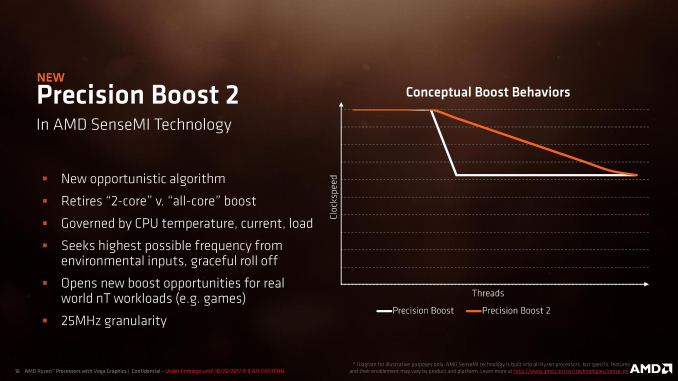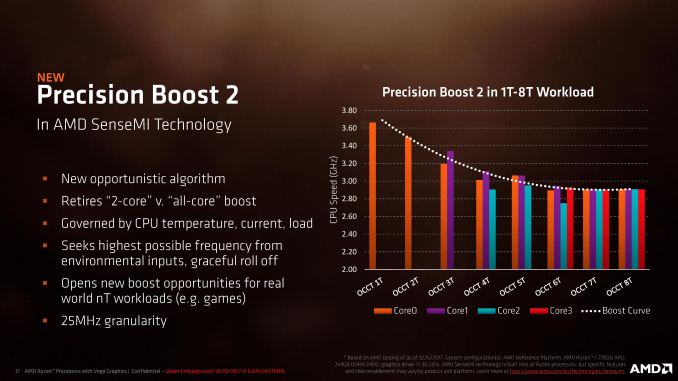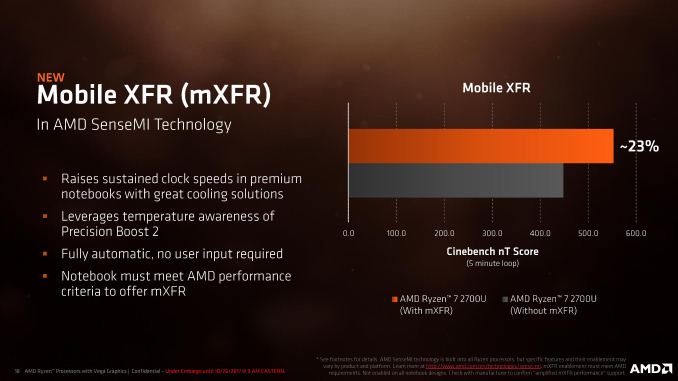Ryzen Mobile is Launched: AMD APUs for Laptops, with Vega and Updated Zen
by Ian Cutress on October 26, 2017 9:00 AM ESTSense Me Ryzen: Better Boost
When AMD launched the desktop Zen processors, it also branded a series of five technologies under the ‘SenseMI’ name. We covered these in detail in our Ryzen 7 review, but in short, it covers the following:
- Pure Power: Sensors to optimize power consumption
- Precision Boost: Determines how Turbo is applied
- Extreme Frequency Range: Going above maximum turbo when possible
- Neural Net Prediction: Using Neural Nets for prefetching data
- Smart Prefetch: Algorithms that work to enhance prefetch
With Ryzen Mobile, the features relating to frequency get an updated model, while Pure Power gets a bigger boost. We’ll cover the power changes on the next page, but it is worth talking about how AMD has improved Precision Boost and brought XFR to laptops.
Precision Boost 2
Most CPU turbo algorithms work by sensing how many cores and threads are under load, determining if the CPU has enough power headroom, and applying a voltage. This is why in the past both of the major x86 CPU manufacturers will quote a ‘per-core turbo frequency’ to show what the frequency should be when different numbers of cores are loaded and all else is fine (there is temperature/power headroom).
For Ryzen Mobile, AMD is pivoting to a new turbo model. When the system is in the P0 (top) turbo state, the system will use a new opportunistic turbo algorithm that rather than being based on the cores under load, is governed by CPU temperatures, currents, and how much load is being applied. The algorithm takes into account all the environmental inputs, such as skin temperature sensors and battery life, and will provide the best turbo frequency it can, regardless of if one thread is being used or all threads are being used.
It will be able to provide boost amounts at the 25 MHz granularity level, similar to how the desktop processors work, with the idea being that in most cases, if the system has a lot of cores available and a background process performs some very light work (such as checking for updates), rather than dropping 500-800 MHz because more cores are loaded, the system will keep at the high frequency.
AMD is stating that this has a big effect on real-world workloads, typically those that have variable thread workloads such as gaming.
When asked if Precision Boost 2 would be coming to the next generation of AMD’s Desktop Ryzen processors, I was told that ‘it could be inferred / it’s a safe bet’.
Mobile Extended Frequency Range (mXFR)
Because mobile systems are thermally limited, battery limited, power limited, and battery limited, offering ‘extra’ turbo headroom is not really something that processor manufacturers like to do. As a result, most of the Ryzen Mobile-powered notebooks will not have any form of XFR – AMD will be allowing it on a case-by-case basis for vendors that overengineer their chassis to be capable of supporting a higher power profile.
This feature essentially extends the average level at which Precision Boost 2 will operate, and also marks what could be considered a higher configurable TDP. One of the systems being launched with Ryzen Mobile this side of Christmas will be mXFR enabled, because the chassis is designed for 25W rather than 15W. It is worth noting that AMD states the configurable TDP of the Ryzen Mobile chips goes up to 25W, so this is likely the case what is happening.
Encode and Decode
AMD is fully using Vega’s encode and decode capabilities with Ryzen Mobile. The big inclusion for AMD’s mobile devices is the ability to decode VP9, the codec prefered in particular by YouTube.
| AMD Ryzen Mobile Encode/Decode Capabilities | |||||
| Decode 1080p @ 4:2:0 |
Decode 2160p @ 4:2:0 |
Encode 1080p |
Encode 1440p |
Encode 2160p |
|
| MPEG2 | 60 FPS | - | |||
| VC1 | 60 FPS | - | |||
| VP9 8/10 bpc | 240 FPS | 60 FPS | |||
| H.264 8 bpc | 240 FPS | 60 FPS | 120 FPS | 60 FPS | 30 FPS |
| H.264 10 bpc | 240 FPS | 60 FPS | |||
| HEVC 8bpc | 240 FPS | 60 FPS | 120 FPS | 60 FPS | 30 FPS |
| HEVC 10 bpc | 240 FPS | 60 FPS | |||
| JPEC 8bpc | 240 FPS | 60 FPS | |||













140 Comments
View All Comments
kulareddy - Thursday, October 26, 2017 - link
But GPU architecture is Vega.MajGenRelativity - Thursday, October 26, 2017 - link
And?artk2219 - Thursday, October 26, 2017 - link
Newer is not always better, just look at the P4 and Bulldozer for examples of that (Not that Vega is bad, far from it). But honestly you're comparing a 15w part with something that's like 110w. Yes efficiency and node shrinks help immensely, but there's still something to be said for higher power limits on older hardware. Now it does have support for newer modes and newer instruction sets so in time it could get better, but I dont think it will ever really run away from the performance level of the xbox one or ps4 in any meaningful way. All that being said, you'll have all of that performance in a thin and light that you can travel with.https://www.anandtech.com/show/7528/the-xbox-one-m...
MajGenRelativity - Thursday, October 26, 2017 - link
Exactly. Vega has a lot of promise, but its performance remains mostly untapped for now.guidryp - Thursday, October 26, 2017 - link
Vega is really no faster clock for clock, than previous generation.Also, this APU doesn't have nearly the bandwidth that the PS4 has, nor the EDRAM cache that the XB1 has, so GPU performance will not match up to those.
Samus - Thursday, October 26, 2017 - link
That's only true when comparing legacy software under both platforms. There are pretty substantial IPC gains, but they require optimization. It's the same reason MMX, SSE, 3DNOW, etc, all had pretty substantial benefits to programs that utilized them, and those were simply extensions of current architecture. Zen is an entirely new x86-compatible model.StevoLincolnite - Friday, October 27, 2017 - link
Vega is much faster than previous generations especially when compared to GCN1.0.And especially in bandwidth constrained scenario where AMD's Delta Colour Compression and improved culling comes into play.
DDR4 2400Mhz is one such bandwidth constrained scenario.
AMD should have thrown DDR4 3200Mhz or more support at the problem.
Alexvrb - Saturday, October 28, 2017 - link
Frequency by itself doesn't tell you the whole picture. Ryzen on the desktop had good bandwidth at a given frequency, so I think Ryzen Mobile will do fine against Kaby Lake Refresh. It doesn't have to worry about cross-CCX latency, so there's reduced need for faster clocked RAM.Also, it's not as easy as "turn this knob and get a perfect IMC that does all the things for zero power". They did the best they could. Not to mention you won't see support for high speed RAM in most laptops running integrated graphics. So for Ryzen Mobile it's actually better to extract as much bandwidth as they can from more common RAM.
Gigaplex - Thursday, October 26, 2017 - link
You're not taking into account the memory architecture. The consoles use faster memory, and these APUs are generally memory bandwidth limited.StevoLincolnite - Friday, October 27, 2017 - link
Consoles also don't have delta colour compression and the tiled rasterizer.So whilst it wont have the same bandwidth as say... The PS4 in theoretical terms. It would likely beat the Xbox One S.